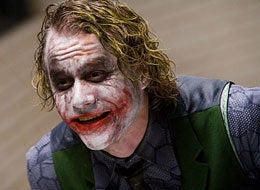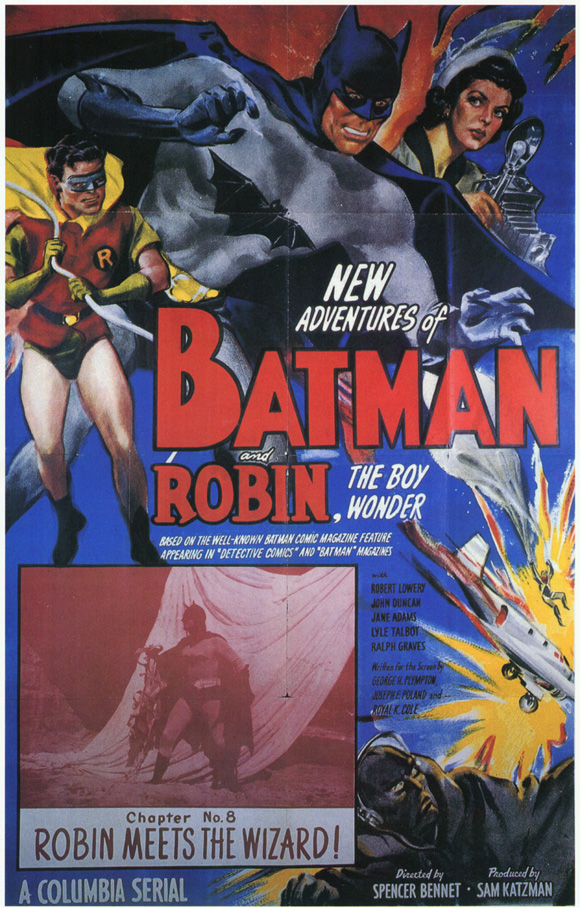
Note: This is the second of seven reviews of the Batman serials and movies that prefigure the current Christopher Nolan/Christian Bale cycle. (The first can be read here.) For many, it'll be too much information. For others, it won't be enough. Apologies all around.
It's six years after the first Batman serial and what's happened? Well, the comic-relief Alfred has been replaced by the no-nonsense Alfred and the comically grandstanding Captain Arnold has been replaced by the no-nonsense Commissioner Gordon and the no-nonsense girlfriend, Linda Page, has been replaced by the more alliterative, and more Lois Lane-like, Vicki Vale, who's better for, yes, comic relief. We were a little more serious in a postwar world but women were still good for a laugh.
 We were also a little blander. Batman is now less vigilante than establishment figure. He doesn't drop off crooks at the local precinct with bat stickers on their foreheads; now he hangs with Commissioner Gordon in his office and plots strategy. He arranges for crooks to escape or for misinformation to be disseminated. Once he reaches this point one wonders -- yet again -- what's the point of the bat costume. It used to strike terror in the hearts of criminals but is anyone afraid anymore? Particularly since this particular cowl is so cheap and loose he often has to tilt his head up just to see.
We were also a little blander. Batman is now less vigilante than establishment figure. He doesn't drop off crooks at the local precinct with bat stickers on their foreheads; now he hangs with Commissioner Gordon in his office and plots strategy. He arranges for crooks to escape or for misinformation to be disseminated. Once he reaches this point one wonders -- yet again -- what's the point of the bat costume. It used to strike terror in the hearts of criminals but is anyone afraid anymore? Particularly since this particular cowl is so cheap and loose he often has to tilt his head up just to see.
Remember when he used to terrorize crooks into confessing in his "bat's cave"? No more. The batcave (possessive dropped) is now bigger, with computerish doo-dads and chemistry equipment and microscopes. It's a workstation. Americans work. The Batmobile still isn't parked there, though. The Cadillac he drove in '43 has been traded in for a Mercury convertible that Bruce Wayne, living in the suburbs, parks on the street, and that Batman and Robin often "borrow." Vicki Vale confronts Batman with this fact in chapter 7 ("The Fatal Blast"):
Vicki: Does Bruce Wayne know you're driving his car?
Batman: Of course.
Vicki: You know, if I didn't know Bruce Wayne so well I'd almost think that you and he were the same man.
Batman: That's absurd.
The racial stereotypes are gone. Race is gone. Everyone's white now. Everyone's bland. What did the Japanese spy, Prince Daka, have in '43? Zombies and an "atom-smasher gun" that prefigured our own atom bomb. What does the Wizard have? A "remote-control machine" that can control any moving vehicle within 50 miles, and a "neutralizer" that neutralizes same. These are clean, bureaucratic names. We also get an early version of techno-babble, which, in '43, wasn't deemed necessary. How did Daka make zombies? He strapped this thing on their heads, zapped them with electricity and bob's your uncle. But in the atomic age, we needed pseudo-scientific explanations:
Batman: Let me ask you scientists a question. The remote control machine at full power can cause disintegration, is that right?
Scientist: Yes, molecular disintegration.
Batman: And the neutralizer with its electromagnetic force can check the disintegrating rays, right?
Scientist: That's correct.
Batman: Now if the beams from each machine crossed each other, what would happen to an object they focused on?
Scientist: Disintegration would be checked. The object would become invisible to the human eye!
Batman: You see? The Wizard...can make himself invisible!
This power of The Wizard's leads to one of the funniest police dispatch calls ever. Imagine a bored, nasal voice: "All the cars in the vicinity of 616 Main Street. Invisible man, the Wizard, there now, in phone booth in lobby. That is all."
In the '43 version, made during World War II, we knew who the enemy was. In this one, made as the Cold War was getting chilly, the enemy is hooded, and the filmmakers play a kind of shell game. In the first episode, officials in Washington D.C. ask Commissioner Gordon to look into the safety of the aforementioned "remote-control device," but, just as he's doing so, just as Batman and Robin are arriving in their Mercury convertible, the device is stolen by the Wizard's henchmen. The device was created by a Prof. Hamill, who, we're told, has grown "eccentric," and he arrives unbidden in a wheelchair. Later, in his home, we see Hamill ("the wheelchair invalid," Robin calls him) lock himself in a secret room, zap himself with electricity, stand reinvigorated and then walk out a secret panel in his office. Cut to: The Wizard entering his lab.
But the serial keeps rounding up more usual suspects. Could The Wizard be the private dick, Dunn, who's always snooping around? Could he be the radio broadcaster, Barry Brown, who always seems to know what the Wizard is up to? In the later episodes, Hamill's assistant, Carter, becomes a possibility, but he's shot and killed by the off-screen Wizard, and in the end Prof. Hamill isn't the Wizard. But it raises the question: What was his electric chair all about? And if it could temporarily reinvigorate him without side effects, why is he keeping this information to himself? Weren't there a lot of wheelchair invalids in 1949 who might benefit?
Serials were dying by '49 and the budget Columbia allocated was probably less than in '43. They got a better Batman -- Robert Lowery reminds me of a lean Victor Mature -- but his suit seems made from felt. He still loses fights, sometimes one-on-one, but at least he knows how to throw a punch.
A better Batman but a worse Robin. They went older and duller. 1943's Douglas Croft (who played younger versions of Ronald Reagan, James Cagney and Gary Cooper in, respectively, Kings Row, Yankee Doodle Dandy and The Pride of the Yankees) was full of Dead-End-Kid enthusiasm but by '49 America was worried about its teenagers and their possible juvenile delinquency and so this Robin practically sleepwalks through the enterprise. He can barely get his lines out. You find yourself doing mouth exercises every time he talks.
Even the opening credits are duller. No cool bat-logo, no eerie music. Instead, Batman and Robin, in their lousy felt outfits, run into camera frame, and then spend half the credits looking around, presumably for bad guys, while a marching beat plays. Then they're in their car, looking straight ahead, occasionally talking, while the steady marching rhythm continues.
How odd. During the last world war we weren't marching but four years later we were.